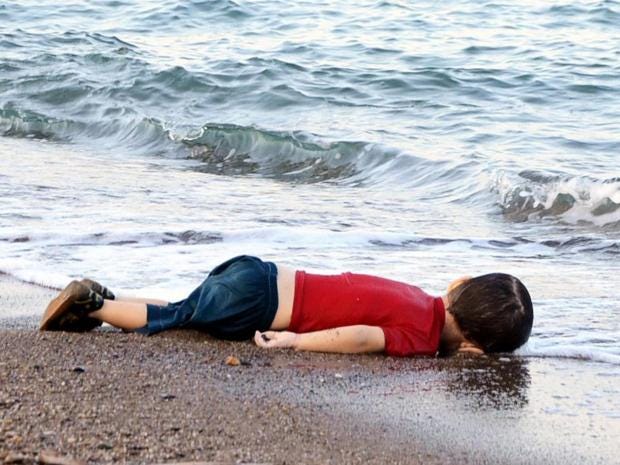Can Photographs Change the World?
Warning: There are graphic images in this post.
---
Along the lines of what I’ve previously written about photojournalism regarding images of children in war, the image that I’ve chosen is graphic as it depicts a deceased child. The child is not laid in a respectful pose, cleaned for viewing. Its simple and raw in the sense that there’s not much else to interpret from the photo besides the lifeless body in the photo. Alan Kurdi (sometimes spelled Alyan), a three year old Syrian boy that was photographed washed up on shore after drowning trying to escape to the Greek island of Kos. The Turkish journalist Nilufer Demir had been the one to capture the image which went viral and little Alan had become a symbol of the plight of the syrian refugee.
Kids for me, like many, are a soft spot. They are the most vulnerable, the most innocent and yet we see them suffering the most. The article Censorship of War Casualties in the US really had me thinking about the multiple factors that are intertwined with image exposure. The censoring of "flag-draped coffins" was common for the administration at the time. And even more explicit photographs regarding "questionable sexual acts" committed by some in the military never made it to the American media. In reference to Professor Nordell's video where he speaks about the "narrowing of vision of the media" brings me to force myself to be my own kind of slueth in regards to world events. I consider these events that have happened during my lifetime that I have been shielded from and would've continued to be shielded from if I had not taken the steps to remove the veil myself to see the truth. It's images like little Alan that make me want to open my eyes and ask questions, instead of continuing to look the other way.
Kids for me, like many, are a soft spot. They are the most vulnerable, the most innocent and yet we see them suffering the most. The article Censorship of War Casualties in the US really had me thinking about the multiple factors that are intertwined with image exposure. The censoring of "flag-draped coffins" was common for the administration at the time. And even more explicit photographs regarding "questionable sexual acts" committed by some in the military never made it to the American media. In reference to Professor Nordell's video where he speaks about the "narrowing of vision of the media" brings me to force myself to be my own kind of slueth in regards to world events. I consider these events that have happened during my lifetime that I have been shielded from and would've continued to be shielded from if I had not taken the steps to remove the veil myself to see the truth. It's images like little Alan that make me want to open my eyes and ask questions, instead of continuing to look the other way.
"Alan Kurdi" (2015)
Photograph by Nilufer Demir (https://www.independent.co.uk/voices/syrian-refugees-libya-two-years-alan-kurdis-death-a7925616.html)
So the question is: Can Photography Change the World?
"Falling Man" (2001)
Photograph by Richard Drew (https://motherboard.vice.com/en_us/article/mggbey/long-fall-the-most-famous-9-11-photo-is-still-suspended)
The image I chose supports the idea of photography possibly changing the world is the photo “Falling Man” by Richard Drew. The man is often described as "flying" because of how almost peaceful the 10 seconds of his fall of his death were. The image is heartbreaking when you consider what the thought process was for him. We often hear the statement: "Imagine what it had to be like up there for people to choose to jump to their death." And it's that process of us really trying to place ourselves in these victims shoes and understand that fueled the anger that took us into war. It became very personal. The events of September 11th completely changed the way our nation operates when it comes to security. Flying and navigating airports is an event in itself, as we now take extended amount of caution to clear flyers. Politically, we jumped into offense mode and deployed the nation’s bravest into an environment they could never prepare for. That resulting in a number of causualties edging close to 7,000. And even socially, the way we approach those not like “us”, particularly of islamic religion or middle eastern descent.
Photographs in general cause buzz, and sometimes buzz causes change. Politically, economically and socially we are affected by the images we consume. A more lighthearted example is the case of Boris Yeltsin, where an image of him dancing and having fun would cause him to win an election. Jonathan Klein stated that photographs didn't change the world, but it was the actions we take that do. It's a statement that does challenge my belief that photographs change the world. And I still do sway on this argument. I have to take into account the plethora of striking images that we are exposed to already so often and yet still don't make the change. How many images of children being pulled from the rubble or demolished homes have we scrolled by on our phones and seen lack of action from our government or governments abroad? So technicially, the photo doesn't change the world. It has to be a choice to make the change.
References:
Do Photographs Change the World?:
Censorship of War Casualties in the US:
Photograph of Boris Yeltsin Dancing:



Comments
Post a Comment